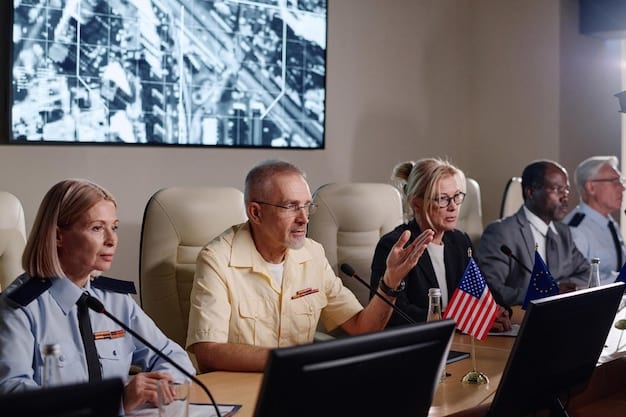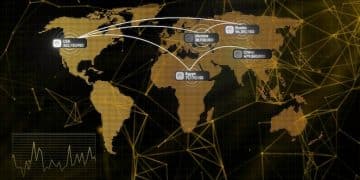Analyzing the US Approach to Nuclear Non-Proliferation in 2025

Analyzing the US Approach to Nuclear Non-Proliferation in 2025 requires a multifaceted assessment of evolving global security dynamics, technological advancements, and geopolitical strategies to gauge the effectiveness of current policies and anticipate future challenges in safeguarding against nuclear proliferation.
The landscape of international security is constantly shifting, making it crucial to understand the future of nuclear non-proliferation efforts. This article delves into analyzing the US Approach to Nuclear Non-Proliferation in 2025, examining the strategies, challenges, and potential outcomes that lie ahead.
Understanding Nuclear Non-Proliferation
Nuclear non-proliferation is a critical aspect of international relations, aiming to prevent the spread of nuclear weapons and technology. The United States has historically played a significant role in promoting and enforcing non-proliferation efforts, working with international organizations and other nations to maintain global security.
The stakes involved are extraordinarily high, making it essential to maintain vigilance and adapt strategies to counter emerging threats. This section offers a foundational understanding of nuclear non-proliferation before further consideration of the US approach and the possible state of affairs in 2025.
Historical Context of Non-Proliferation
The history of nuclear non-proliferation is rooted in the aftermath of World War II and the development of nuclear weapons. The first efforts to control nuclear technology were formalized with the creation of the International Atomic Energy Agency (IAEA) in 1957.
- The Treaty on the Non-Proliferation of Nuclear Weapons (NPT), which came into force in 1970, is the cornerstone of global non-proliferation efforts.
- The NPT aims to prevent the spread of nuclear weapons, promote disarmament, and foster cooperation in the peaceful uses of nuclear energy.
- The United States has been a key supporter and enforcer of the NPT, working to strengthen its provisions and address emerging challenges.
Understanding this historical context is essential to grasp the complexities of the current non-proliferation landscape. These initial efforts laid the foundation for future strategies and international cooperation.
In conclusion, nuclear non-proliferation has deep historical roots and complex international dimensions. By understanding these foundations, one is better prepared to appreciate the nuance of the policies and plans for analyzing the US Approach to Nuclear Non-Proliferation in 2025.
Current US Non-Proliferation Strategy
The United States currently employs a multifaceted approach to nuclear non-proliferation, integrating diplomatic, economic, and security measures. These strategies are designed to prevent the spread of nuclear weapons, secure nuclear materials, and promote disarmament efforts worldwide.
The specific tactics and areas of emphasis are subject to modification based on prevailing geopolitical conditions and technological advancements. A review of these strategic elements offers insight into how one might go about analyzing the US Approach to Nuclear Non-Proliferation in 2025.

The current US strategy involves close collaboration with international partners, including the IAEA, to monitor and verify nuclear activities. This helps ensure transparency and compliance with non-proliferation agreements.
Key Elements of the Strategy
Several key elements define the current US approach to nuclear non-proliferation. These include diplomatic engagement, security assistance, and technology controls.
- Diplomatic efforts focus on negotiating and enforcing non-proliferation agreements with other countries, as well as addressing potential proliferation crises through multilateral diplomacy.
- Security assistance programs help other nations secure their nuclear materials and facilities, reducing the risk of theft or diversion.
- Technology controls prevent the transfer of sensitive technologies and materials that could be used to develop nuclear weapons.
These elements work together to create a comprehensive framework for preventing nuclear proliferation. The ultimate goal is to minimize the risk of nuclear weapons falling into the wrong hands.
The US non-proliferation strategy also involves efforts to promote disarmament. Though the US retains nuclear weapons, it participates in international efforts to reduce the size and role of nuclear arsenals.
Emerging Threats and Challenges
The landscape of nuclear non-proliferation is constantly evolving, with emerging threats and challenges posing new risks. These include the proliferation activities of state and non-state actors, advancements in nuclear technology, and geopolitical tensions that undermine international cooperation.
Therefore, analyzing the US Approach to Nuclear Non-Proliferation in 2025 involves acknowledging these ever-evolving threats and challenges.
One of the most significant challenges is the risk of proliferation by state actors seeking to develop nuclear weapons. Countries like North Korea and Iran have pursued nuclear capabilities in defiance of international norms and agreements. This has led to increased tensions and heightened security concerns.
Non-State Actors and Nuclear Terrorism
The threat of nuclear terrorism by non-state actors is a major concern for the US and the international community. Terrorist organizations could potentially acquire or develop nuclear weapons, or radiological materials, to carry out attacks.
- Securing nuclear materials and preventing their theft or diversion is a top priority for the US and its partners.
- Efforts are underway to strengthen nuclear security measures worldwide, including enhancing physical protection, improving material accounting, and countering insider threats.
- International cooperation and intelligence sharing are essential to address the threat of nuclear terrorism effectively.
Preventing nuclear terrorism requires a comprehensive and coordinated approach. The risk to global security is deemed substantial if any improvements in procedure or material are not adopted.
In summary, emerging threats and challenges are reshaping the landscape of nuclear non-proliferation. Addressing these risks requires a proactive and adaptive approach, as well as sustained international cooperation.
Technological Advancements and Their Impact
Technological advancements are significantly impacting nuclear non-proliferation efforts. Innovations in areas such as nuclear enrichment, weapon design, and cyber warfare pose new challenges for detecting, monitoring, and preventing the spread of nuclear weapons.
Analyzing the US Approach to Nuclear Non-Proliferation in 2025 means recognizing how technological advances will influence future policies and outcomes.
Advances in nuclear enrichment technologies, such as laser enrichment and centrifuge technology, are making it easier to produce fissile materials needed for nuclear weapons. This increases the risk of proliferation, as more countries and non-state actors could potentially acquire these capabilities.
Cyber Warfare and Nuclear Security
Cyber warfare poses a growing threat to nuclear security. Cyberattacks could target nuclear facilities, disrupt operations, steal sensitive information, or even trigger accidents. Protecting nuclear facilities from cyber threats is essential to maintaining nuclear security.
- The US and other countries are investing in cybersecurity measures to protect nuclear facilities from cyberattacks.
- These measures include enhancing network security, improving detection capabilities, and developing incident response plans.
- International cooperation and information sharing are essential to address the evolving cyber threat effectively.
An attack on a nuclear facility carries devastating implications, which underscores the importance of securing such infrastructure against online intrusions.
In conclusion, technological advancements are creating new challenges and opportunities for nuclear non-proliferation efforts. A comprehensive understanding of these technologies is essential for adapting strategies and maintaining global security.

Geopolitical Factors Influencing Non-Proliferation
Geopolitical factors play a crucial role in shaping nuclear non-proliferation efforts. Tensions between countries, regional conflicts, and shifts in global power dynamics can all impact the success or failure of non-proliferation efforts.
Analyzing the US Approach to Nuclear Non-Proliferation in 2025 must take these complex interrelated geopolitical issues into consideration. A failure to do so could very well bring about unforeseen problems.
Regional conflicts, such as those in the Middle East and the Korean Peninsula, have the potential to escalate into nuclear crises. Countries involved in these conflicts may seek nuclear weapons to deter aggression or gain leverage. This increases the risk of nuclear proliferation and regional instability.
The Role of International Cooperation
International cooperation is essential to addressing nuclear non-proliferation challenges effectively. The US works with other countries and international organizations to promote non-proliferation norms, monitor nuclear activities, and respond to proliferation crises.
- The IAEA plays a central role in verifying compliance with non-proliferation agreements and providing technical assistance to countries seeking to develop peaceful nuclear programs.
- Multilateral initiatives, such as the Proliferation Security Initiative (PSI), help to interdict shipments of illicit nuclear materials and technologies.
- Bilateral cooperation between the US and other countries is also important for addressing specific non-proliferation challenges.
Increased cooperation on a global scale could greatly foster a more favorable environment for minimizing nuclear proliferation.
In summary, geopolitical factors significantly influence nuclear non-proliferation efforts. Addressing these factors requires a comprehensive approach that integrates diplomatic, economic, and security measures.
The US Approach in 2025: Predictions and Strategies
Looking ahead to 2025, the United States is likely to continue its multifaceted approach to nuclear non-proliferation. This will involve adapting strategies to address emerging threats, leveraging technological advancements, and strengthening international cooperation.
The predictions and strategies associated with analyzing the US Approach to Nuclear Non-Proliferation in 2025 will depend on ongoing geopolitical events and future progress in nuclear technology.
One likely trend is an increased focus on cybersecurity to protect nuclear facilities from cyberattacks. The US will likely invest in advanced cybersecurity measures and work with other countries to develop international norms for cyber behavior.
Potential Future Strategies
Future US non-proliferation strategies may include an increased emphasis on arms control agreements, efforts to address the root causes of proliferation, and innovative approaches to verification and monitoring.
- Arms control agreements could play a role in limiting the spread of nuclear weapons and reducing nuclear arsenals.
- Addressing the root causes of proliferation, such as regional conflicts and security dilemmas, could help to prevent countries from seeking nuclear weapons in the first place.
- Innovative approaches to verification and monitoring, such as remote sensing and data analytics, could improve the ability to detect and deter proliferation activities.
Each of these strategies require a commitment to cooperation and adherence to internationally agreed norms and practices.
In conclusion, the US approach to nuclear non-proliferation in 2025 will likely be shaped by emerging threats, technological advancements, and geopolitical factors. Adapting strategies and strengthening international cooperation will be essential for maintaining global security.
| Key Point | Brief Description |
|---|---|
| 🛡️ US Strategy | Diplomatic, economic, and security measures. |
| ☢️ Emerging Threats | State and non-state actors seeking nuclear weapons. |
| 🌐 Cooperation | International efforts for non-proliferation. |
| 💻 Cyber Security | Protecting nuclear facilities from cyberattacks. |
Frequently Asked Questions
Nuclear non-proliferation refers to efforts to prevent the spread of nuclear weapons and technology to countries that do not already possess them, aiming to reduce the risk of nuclear war.
The NPT is the Treaty on the Non-Proliferation of Nuclear Weapons, a landmark international treaty whose objective is to prevent the spread of nuclear weapons and weapons technology.
Emerging threats include state actors defying international norms like North Korea and Iran, the threat of nuclear terrorism, and technological advancements.
Cyber warfare poses a growing threat to nuclear security since cyberattacks could target nuclear facilities, disrupt operations, steal sensitive information, or even trigger accidents.
International cooperation is vital to addressing non-proliferation challenges. The US works with other countries and international organizations to promote non-proliferation norms and monitor nuclear activities.
Conclusion
Analyzing the US approach to nuclear non-proliferation in 2025 involves predicting strategies to deal with emerging threats, leveraging technological progress, and strengthening international partnerships. It’s crucial that the United States remains proactive in its commitment to preventing nuclear proliferation. By recognizing these ever-changing elements, the US can adapt its operations to safeguard global security and stability.





